Jennifer Bain1
Three years ago after I delivered a lecture to my medieval music history class on the role of women in medieval music, one student asked the question that has been occupying me for some time:“Why is it that before I took this course I had heard of Hildegard von Bingen, but I’d never heard of any of the other medieval composers we’ve talked about so far, like Leonin or Perotin?” The answer, of course, is not straightforward. Twenty-five years ago this question would not have been asked in a medieval music history class, because very few people at all in the English-speaking world, even those who specialized in medieval music, knew the name of the twelfth-century Abbess and composer, Hildegard von Bingen (1098-1179). Before 1989, Hildegard’s music, like that of most women composers, was completely absent from standard music history textbooks.2 While she merited only a single paragraph in a 1989 textbook devoted entirely to medieval music, today she is a featured composer in the latest edition of the widely-used music history textbook, Grout and Palisca’s A History of Western Music (49, 50). This speedy rise to prominence in the study of music history, however, pales in comparison to Hildegard’s spectacular and influential splash in the marketplace.
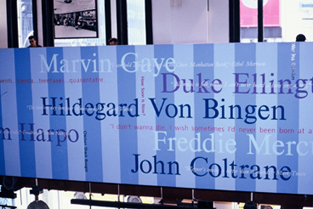
Before 1982 only a few of Hildegard’s seventy-seven songs had been recorded and their amateur performances had virtually no impact in the marketplace. By 1994, however, Hildegard had hit the Billboard charts, and by 1997, one could find Hildegard’s name among other “great” musicians, such as John Coltrane, Marvin Gaye, and Duke Ellington, on the wall at the HMV on 34th Street in New York City. In 2001 her chant “Columba aspexit” (performed by Gothic Voices) was included in a feature film: in A Beautiful Mind schizophrenic genius John Nash listens to a 78 rpm recording of Hildegard in 1947, a year before any of her chant existed in recorded format (in 1948 the monks at the monastery of Saint Benoit du Lac in Québec released the first recording of Hildegard’s music, her “Kyrie,” on their 78 rpm Chants grégoriens disc).
The meteoric rise in Hildegard’s musical reputation can be attributed to several potent causes, including the surge of interest in the 1970s and 1980s in the recovery of women’s history; a new all-vocal approach to the performance of medieval vocal music in the 1980s (as Daniel Leech-Wilkinson describes it, the “re-invention of the a capella hypothesis” [88-156]); the recent centenaries of Hildegard’s birth and death years: the provision of a recording in Hildegard’s death year (1979) by the nuns of Rüdesheim and the proliferation of recordings that appeared throughout the 90s as the 900th anniversary of her birth (1998) approached;and a burgeoning interest in medieval music by the general public in the late 1980s and early 1990s, which Paula Higgins suggests might be attributed to “a desire to retreat to an era of perceived timelessness and spirituality in a world beset by social, economic and military tensions” (118). Katherine Bergeron similarly ascribes the interest in chant in particular to a desire for spiritual experience and ritual outside the confines of religious institutions: the sacral yearnings of a secular society. As she describes it, “Chant is a form of spiritual tourism. It promises the contemporary soul a virtual reality, a virtual sanctity” (34). This paper focuses primarily on two essential and related factors in the rise of Hildegard’s musical reputation. First, I address the effect of a virtuosic recording of Hildegard’s music by the professional early music ensemble, Gothic Voices, and then examine marketing strategies used for medieval music by record distributors in the 1990s, strategies which employ the rhetoric of timelessness and spiritual renewal identified by Higgins. Concentrating on three key releases from 1994, Chant, Vision (both EMI) and Sequentia’s Canticles of Ecstasy(DHM/BMG), I will show how marketing, especially the use of cover images, places Hildegard (and chant more generally) in the New Age sector of the marketplace. This market category casts the sacred music of the Middle Ages as a universal music with a continuous past, evoking a time of intense spirituality easily accessible to modern listeners.
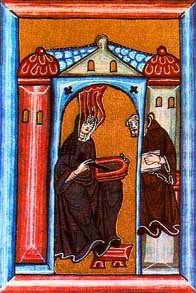
Before the Gramophone award-winning Gothic Voices recording of 1982, Hildegard’s music was unlikely to reach a wide audience with recordings such as the 1960 Aachen Cathedral Choir and Symphony Orchestra arrangement of “O virga ac diadema,” complete with strings, harp, flute and oboe. The wavering pitch and unsteady vocal control of the untrained sopranos in the choir do not contribute to a perception of Hildegard’s melody as particularly beautiful or noteworthy. It took an ensemble dedicated to medieval music, Gothic Voices, with its distinguished director and musicologist, Christopher Page, and the diva of early music, Emma Kirkby, as a soloist, to authenticate and endorse Hildegard’s music in their first recording, A Feather on the Breath of God. The sound of Gothic Voices simultaneously encapsulates and creates the “early music” vocal style that emerged in the early 80s, a style easily recognized in “O Euchari” by its pure sound and lack of vibrato, which contrasts greatly with the church choir from Aachen.3 The vocal timbre achieved by particularly the female voices in Gothic Voices bears a striking likeness to that produced by the English choral tradition; Leech-Wilkinson describes it as “freshly cleaned Anglicanism” (206). In his seminal book on singing style and ideology John Potter similarly argues that the early music “sound” from the 1980s is really the vocal style associated with Oxford and Cambridge college choirs, since most of the professional choirs of the 1970s and 80s devoted to early music primarily consisted of former Oxbridge choral scholars as well as former choirboys (116).
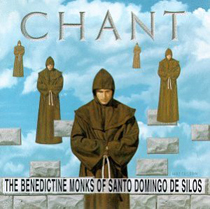
Gothic Voices not only legitimized Hildegard’s music with their credentials and professional sound, but through several key aspects of their performances they strongly contributed to the image of Hildegard as an ecstatic song-writer, the creator of glorious melodies, far exceeding in range and depth the Gregorian chant repertory.4 The sound of Gothic Voices’ seven professional singers, with guest soprano Emma Kirkby performing either solo or with no more than four singers at a time, contrasts significantly with the older style of chant performance. Most earlier recordings feature groups of men, often monks, trained in chant but not in professional singing, producing a style not broadly popular until some clever marketers at Angel Records came up with their now famous visual image for the recording, Chant.5 Another group of monks, a choir from the Abbey of Notre-Dame de Fontgombault, serves as a good example of this older style. Their 1978 recording of a Kyrie demonstrates an unpolished sound of wavering pitch, imprecise endings and beginnings, and a fairly predictable phrase-by-phrase rhythmic impulse. In contrast, Gothic Voices sings Hildegard’s melodies in a soloistic style—even when singing as a group—at a faster pace and with clarity. Although almost every pitch is sung with an equal rhythmic length, there is a strong, rhythmic accentuation to their phrasing, a sense of movement through scalar figures, a slight hesitation on the higher notes just before cadences, as well as a momentum that carries through to the end of each piece. Moreover, crucial to their conception of Hildegard’s sound, Gothic Voices accommodates Hildegard’s ranges of a twelfth or thirteenth by favoring a higher rather than lower register of the female voice. Although some of Hildegard’s music is expansive in range, elevating the melodies in the female voice emphasizes this characteristic and evokes the ecstasy so often attributed to the music. For instance, “Columba aspexit” (which is notated on C), is sung on E, placing its range of a twelfth from B to F2, while “O ecclesia” (which is notated on A), is sung also on E placing its range of a thirteenth from B-G2. With their professional voices, their solo style and intimate portrayals of the songs, as well as their rapid tempo and exploitation of the female vocal register, Gothic Voices’ high caliber performances established a secure place in the repertory for Hildegard’s music, for musicologists and general audiences alike.
In addition to its uncontested and continued commercial success (the CD booklet accompanying the 1986 re-issue claims that it is “widely held to be one of the most successful records of pre-Classical music ever made” [24]), and critical reception (it won a Gramophone award in 1983), it also had an impact on the musicology community. It is after A Feather on the Breath of God appears that music history textbooks begin to include a discussion of her music and one even includes a track from this recording (“Columba aspexit”, the same track that features in A Beautiful Mind in 2001) (Kerman and Tomlinson).
Significant as Gothic Voices’ pioneering recording was, Hildegard’s more recent and grand success in the marketplace had as much to do with marketing strategies as it did with the music itself. Following the Chant craze in early 1994, the marketing of Hildegard’s music increasingly targeted the New Age meditational music buyers, and sales figures for Hildegard recordings soared.

New Age music is difficult to define:
Like the fractal patterns of nature, new age music isn’t a smooth, definable entity, but a shifting maze of intricate relationships that are constantly similar, yet constantly different. (Diliberto 44)
When New Age was adopted as a music industry term in the early 1980s, it embodied a new instrumental music embracing elements of acoustic, world, folk, space, jazz and classical into a hazy hybrid. (Diliberto 60)
“New Age”–whether one applies the term to music or sex or religion or politics or diet or psychology–is a sensibility that deliberately eludes the chains of definition. (D. Hall 13)According to David Regneri, who sells it in his music store, it is various musics linked to the values claimed since 1973 by New Age Journal: “wholeness, spirituality, relationships, self-healing, universal brotherhood and sisterhood, creativity, and oneness with the universe.” Developed mostly in Germany, Japan, and California, it includes “Space Music,” electronic music with a dreamy, “otherworldly” quality; George Winston’s piano music with a “percussive style” that is yet flowing and quiet; Celtic harp; Japanese folk melodies on flute; singing in Gaelic; Mozart played on synthesizer, sampler, and acoustic instruments and inlaid with “naturally recorded” ocean sounds; Native American chanting and singing combined with synthesized music. What all these types have in common, Regneri said, is that they are relaxing, calming, and mediatative for certain people. “Pachelbel’s Canon,” he noted, “played slowly so it’s relaxing becomes New Age music.” (S.G. Hall 23)
New Age music’s consciousness-changing abilities can increase the mental and emotional health of those who listen to it. Whether used as ambient or foreground sound, the music can evoke feelings of peacefulness, joy, relaxation, gentle stimulation without distraction, intimacy, and sometimes even bliss…It aids mental concentration (or defocusing) for superior meditation, inner awareness or “out of body” traveling. (Birosikx)
New Age music is at once both a style and a genre, a category created by the music industry (Aidan A. Kelly describes it as a “marketing slogan, not a musical category” [295]). As a style New Age music is associated with breathy, slow, arhythmic, droning, synthesized music; as an industry category New Age music encompasses many other types of music, such as World Music, Folk Music, Electronic Music and Gregorian Chant, frequently without alteration in style. Indeed, by 1989 Gregorian chant was listed as a category within the Vocal Music sub-genre of New Age Music in Patti Jean Birosik’s New Age Music Guide (162). This association of Gregorian Chant with meditation or relaxation was picked up very quickly by record producers. Music critic David Littlejohn reports that a private poll conducted by the Spanish branch of EMI in 1993 revealed that, “many young Spaniards owned and played chant records, often for relaxation purposes” (24). It was this poll that led EMI to compile 19 tracks recorded in the 1970s and early ‘80s by the now famous Benedictine Monks of Santo Domingo de Silos, and release the album as Las Mejores Obras del Canto Gregoriano in Spain in late 1993. Determined to attract the under-25 crowd, EMI used television advertising to great success; projecting sales of 30-50,000 copies, by early 1994 EMI had sold 300,000 (24).

Later in 1994 in the US, Angel Records (an EMI affiliate) released the same album under the title Chant with a new, slick (and now very familiar) cover, depicting monks floating with the clouds in the sky (a New Age emblem I will discuss later) which created a media sensation apparently due to its record number of sales. It had sold a million copies within a month of its release (Littlejohn 25) and by 1996 American sales figures topped 3 million (24).6 I would argue, that the media created a selling sensation when they embraced Angel Records’ intensive marketing strategies. In addition to Angel Records’ massive press release, they also launched a huge sales campaign through print, radio and cable-television advertising. Furthermore, as David Littlejohn writes, “reaching out to record store owners, Angel Records shared the cost of local ads, and offered hooded souvenir T-shirts as well as giant posters and cardboard cutouts of the monks” (24-25). Because of this intensive campaign, stores throughout America ordered enormous quantities of the album and Chant reached number twelve in Billboard’s top classical record sales before it was available to the public, before a single CD was purchased by an individual. By relying on shipping figures rather than actual sales figures and ranking Chant as number twelve, Billboard itself created a demand for this hugely “successful” CD. Importantly, this can no longer happen. Billboard’s sales figures are no longercalculated according to the quantity shipped, but rather the quantity sold.
In a study that addresses the uniformity of style in the cover art of New Age recordings, Helfried Zrzavy details five elements that proliferate, including depictions of landscape: (1) stark covers, (2) landscape photographs, (3) painted, abstract art, (4) free-form fantasy landscapes, and (5) absence of the artists (41-48).The depictions of landscape—whether photographic or fantasy—usually emphasize the sky and clouds, which evoke both nature and the spiritual realm so important to the New Age aesthetic, illustrated on many New Age CDs: Windhorse Riders, Out of the Wind, Like an Endless River, Chiaroscuro, The Song of Angels, and even on a TV guide cover (see Figure 5). The cover of Chant—with its sky and clouds—places it in the New Age sector of the marketplace, although Chant appeared on the classical charts and the recording does not incorporate a New Age style.7 Since the phenomenon of Chant in 1994, discrepancies have arisen increasingly in the promotion of chantrecordings between the content of the CDs and what the covers suggest. Because the music industry has appropriated chant as a category of New Age music—whether or not the performance style makes use of New Age techniques—it is sometimes impossible to tell what style of performance to expect from a CD when both kinds of recordings are marketed in the same way. Drawing on the success of Chant and its marketing style, many Hildegard recordings also target New Age audiences through their covers, whether or not the recording itself uses a New Age style of performance.
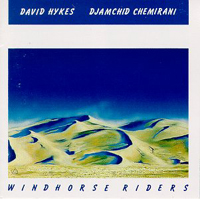
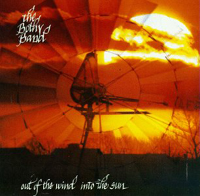

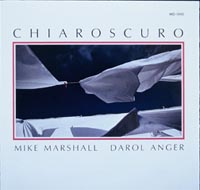
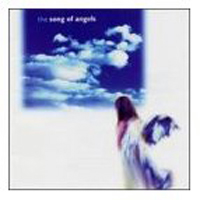
Figure 5 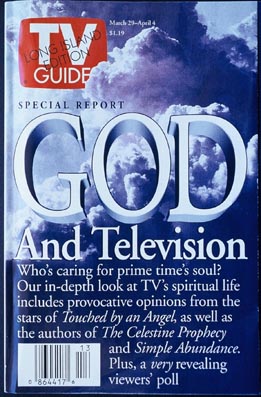
1994 was also the year that Angel Records released Vision: The Music of Hildegard von Bingen. As Timothy Taylor reports, Vision was an obvious attempt on the part of Angel to capitalize on their success with Chant:
The monks refused to make a second album for EMI/Angel, saying they had been underpaid for the first one, so Angel scrambled to recreate the success of Chant. Hence, the cover art of Vision is remarkably similar to Chant; even the font is the same. (14)

Vision, like Chant, uses the sky and clouds motif to appeal to the New Age market. But unlike Chant, Vision features World Music rhythms, as well as the reverberation, airy timbres, ambient synthesizer and atmospheric swells associated with New Age music. These elements can be heard in “Laus trinitati,” firmly placing Vision in the New Age style category.
Although the text on the cover proclaims this recording as Hildegard’s music (which we know to be monophonic chant), in David Foil’s liner notes we discover that the idea behind the CD was “to record Hildegard von Bingen’s music in its purest form and marry it to the imaginative concepts of the contemporary American composer Richard Souther, using contemporary pop and world-music sounds that reinvent the startling immediacy, the piercing beauty, and the sublime spirit of Hildegard’s art [emphasis mine]” (5). Foil’s language seems to claim several levels of authenticity for the recording: the “pure” performances of Hildegard’s chant (sung by early music singer Emily Van Evera and a “real” nun from New Jersey, Sister Germaine Fritz) and the creative vision of Richard Souther. Taylor points out this same claim to authenticity in the press release issued by Angel, which refers to the use of “two unique vocalists for authenticity, Sister Germaine Fritz, a Benedictine nun, and Emily Van Evera, a world renowned early music vocalist and historian” (15).8 Curiously, although the liner notes state that Souther used “contemporary pop and world-music sounds” to “reinvent” Hildegard—granting him authenticity as a creator, Taylor reports that “world-music sounds” are the least authentic feature of the album: “The promised world rhythms turn out to have been available on a CD collection entitled Supreme Beats: A Percussion Library by Bashiri Johnson.This 4-CD set reportedly took six months to complete and contains 650 grooves in four hours, in four categories: ‘contemporary,’ ‘dance/hip-hop’, ‘African’, and ‘world’.” Available for $350, the collection is aimed at anyone “who use[s] sampling as a creative tool” (16). The cover art of Vision is notable for its use of two forms of neumatic notation, the late medieval square notation in the border and the earlier neumes (such as those found in Hildegard’s manuscripts) which float disembodied in the cloudy sky behind Hildegard herself. The appearance of these neumes, stripped of meaning and context and used here as pure decoration, strongly reflects the way in which Hildegard’s music has been taken out of its own context through the style of performance on the album. The rather modern almost photographic depiction of a youthful nun—wearing lipstick—with stars sparkling in her head covering (a halo for the twentieth century?), similarly de-historicizes Hildegard the person.
Before 1994 most Hildegard recordings bore the standard somewhat intimidating early music cover: a border around the edge with either a tasteful illumination, such as the one from Hildegard’s Scivias pictured on Gothic Voices’ 1982 LP (Page 24) or a photograph of a medieval art object such as the late tenth-, early eleventh-century ring pictured in front of a twelfth-century book or box cover on a 1980 Christophorus CD (Hohlfeld 15). The early music ensemble Sequentia released two recordings with Deutsche Harmonia Mundi, which neatly fit this category by using illuminations from an early thirteenth-century Hildegard manuscript on their Ordo virtutum LP from 1982 (Thornton 63) and on their Symphoniae LP from 1985 (Dronke and Thornton 4).
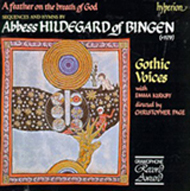
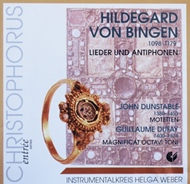
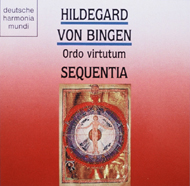
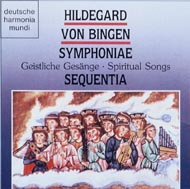
Figure 7
But in 1993 Deutsche Harmonia Mundi got rid of their standard gray borders, and allowed their art departments to be freer with the covers (Bagby). This change of cover format occurred in the year previous to Sequentia’s 1994 release, Canticles of Ecstasy. In both title and cover design Sequentia radically changed their look; from the rather conservative Latin titles, Ordo virtutum and Symphoniae, Sequentia chose the fanciful Canticles of Ecstasy, a name reminiscent of New Age titles such as Dream Generator, White Winds, and Aerial Boundaries. As Benjamin Bagby reports, at that time co-director of Sequentia with the late Barbara Thornton, the cover was submitted by Sequentia but developed by the art departments. He says:
In Europe, they took the artwork we submitted (from a Hildegard ms. copy) and added the title in Helvetica typescript (also our request). It was very elegant and true to the original … The art depart[ment] of BMG in New York was told to “pop it up” for the more aggressive American marketplace, since the NY management found our version “too European,” and they changed the typeface and colors radically. We were not informed of this until it had been done.8
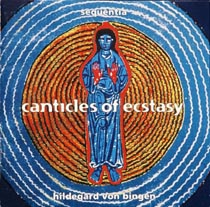
Although still using an illumination from a Hildegard manuscript, the image is no longer a foreground element, but rather foreground and background together. The “popped up” version with its garish colors reinforces the spherical image associated with the medieval conception—which Hildegard espoused at length—of the human as the microcosm in the macrocosm of the universe.10 This visual image—though not described by Zrzavy—appears on New Age books, magazines and CD covers, as in Mickey Hart’s Planet Drum CD cover of the earth surrounded by the spherical, heavenly cosmos and constellations , and in Ismaël Lo’s Jammu Africa “World Music” CD advertised in New Age Journal (70). Sequentia’s 1995 release, Voice of the Blood, continues this trend with its evocative title and spherical image, taken from another Hildegard illumination and again used as foreground and background together (Thornton 5).
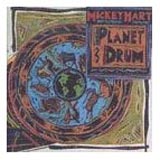
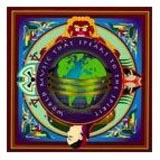
Figure 9 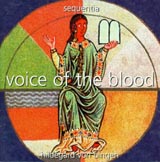
At the point of the Canticles of Ecstasy release in 1994 in the Hildegard recording industry, cover art more frequently became divorced from content; the music industry marketed Hildegard’s chant as New Age music whether or not it incorporated a New Age style, either through “updating” the music or through unusual drones and reverberation. From the cover of Canticles of Ecstasy we expect to hear New Age ambient music: long drones on the synthesizer, the use of ethereal synthetic voice and string sounds, and heavy reverberation, something like Enya’s Watermark from 1987, a popular and classic New Age recording.11 But Canticles of Ecstasy sounds just like the Sequentia of old, a singing style somewhat similar to Gothic Voices—highly trained female voices often using solo performances, but frequently with the addition of medieval instruments, and—most indicative of their style—with a much freer rhythmical interpretation. Sequentia uses rapid rising and descending figures which sound like embellishments to the main melodic notes, and they emphasize climaxes and phrase endings with longer held notes, as for example in their a capella version of “Quia ergo femina mortem instruxit.” Their interpretation of Hildegard’s music is highly individual but does not in any way attempt to use New Age stylistic techniques.
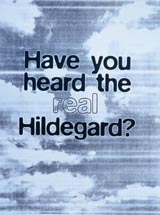
With the release of Canticles of Ecstasy in its New Age-style cover, BMG, Deutsche Harmonia Mundi’s distributor, took advantage of the flashy and successful Chant CD, and launched a Chant-like campaign. Figure 10: BMG press mailingBMG blitzed the media with a massive press mailing which included a copy of the CD, and also sent large numbers of posters and cutouts to the stores. The cover page of the press release for Canticles of Ecstasy, in a very deliberate attempt to place itself in the New Age sector of the marketplace, appropriates the New Age sky-and-clouds motif. But at the same time the cover recalls the VisionCD in order for Canticles of Ecstasy to assert its own style of authenticity—in historical performance practices—with the provocative text, “Have you heard the REAL Hildegard?” The result? By 1997 Sequentia’s highest sales figures to date—100,000 CDs in North America alone, six times the number of their first release, the Ordo virtutum.
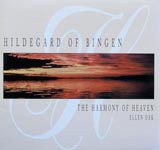
Even before Chant, Vision, and Canticles of Ecstasy appeared in 1994, the relationship between cover and content could be blurred. A sampling of a number of CDs from a few years either side of the 1994 releases shows that the varying relationship between cover art and content was widespread.12 In 1989 Ellen Oak’s Harmony of Heaven, strongly suggests a New Age musical interpretation with its title and its sky-and-clouds-during-sunset-image, but instead the recording comprises a single, a capella soprano singing from the heart in an untrained voice, but not using any New Age techniques, as in “Quia ergo femina.“In stark contrast, the 1990 Diadema recording, by the ensemble, Vox, targets its market with little subtlety, through its fantasy-like illustration of a red-cloaked woman, gazing at mountains and a night sky, and a text on the cover which reads, “Medieval strings, woodwinds and percussion blend with atmospheric synthesizers, wrapping the virtuoso trio of female voices in a shroud of mystery to create a timeless listening experience of luminous depth.” In all aspects of their performance style—synthesizers, swells, slow atmospheric music—Vox applies New Age techniques to Hildegard’s melodies, as in “O Euchari.”
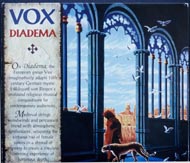
Figure 12 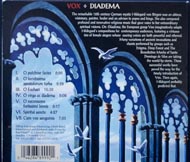
In 1995 two recordings using an early music performance style appeared, an Oxford Camerata recording which maintains the classic early music cover—white background with a thirteenth-century icon by Cimabue, and From Chant to Renaissance by Voices of Ascension, which uses the New Age sky and clouds motif.
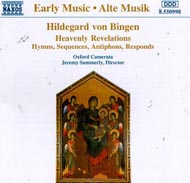
Figure 13 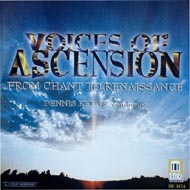
The Camerata provides group and solo performances, adopting a clean, early music sound as in “O ignis spiritus,”while in From Chant to Renaissance, choir member Kathy Theil offers two gorgeous Hildegard tracks a capella, especially “Ave generosa,”drawing on the solo style of Gothic Voices with a clear, polished timbre and on the rhythmic inflections of Sequentia.
In 1996 and 1997 three recordings using varying degrees ofmusicalNew Age techniques appeared, two of which use landscape or sky and clouds images on their covers, Spirits, an album by clarinetist Richard Stoltzman, which has one Hildegard track, and Angeli, a CD recorded by Project Ars Nova, a respected medieval music ensemble known for their recordings of fourteenth-century French music . The third uses a standard early music cover with Lyrichord’s dark border down the left side and a medieval illumination in the center of a pale yellow background, Norma Gentile’s Unfurling Love’s Creation.
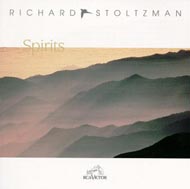
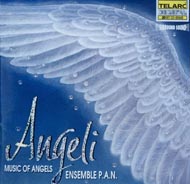
Figure 14 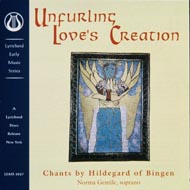
With Project Ars Nova it is difficult to tell if they were truly aiming for a New Age sound, but the strong reverberation and its effect on the echoing drone which accompanies soloists Laurie Monahan and Daniela Tosic in “O gloriosissimi lux” sounds much less like the early music style that they usually adopt. Norma Gentile, who describes herself as an auric healer, draws on another aspect of New Age musical technique by combining two culturally distinct forms of musical practice. In Unfurling Love’s Creationshe sings Hildegard’s melodies to Tibetan Singing Bowl accompaniment, clearly audible in the chorus of drones in “Ave, Maria.” But the clearest example of a New Age style in these three recordings is Richard Stoltzman’s Spirits CD, which claims in the accompanying booklet to be “music soulfully performed with depth by bassist Eddie Gomez, with celestial sonics by guitarist David Torn … [and] with anointing touches by vibraphonist Dave Samuels … ” ([3]). Stoltzman’s rendition of “Ave, Maria” features solo clarinet with atmospheric synthesized accompaniment and occasional percussion.

An examination of the music industry’s packaging of Hildegard von Bingen’s recordings in relation to performers’ interpretations of her music uncovers a marked discrepancy between what musicologists have learned about chant and how chant is represented in the music industry today. Regardless of what the performances actually sound like, in the visual images on Hildegard CD covers and in the language used in marketing materials, record distributors frequently employ the New Age rhetoric of timelessness and spiritual renewal which is currently synonymous with medieval chant. In recordings, the range of performance styles and practices brought to Hildegard’s melodies is extraordinary, especially considering that Hildegard was virtually unknown musically just twenty-five years ago: some performers draw on chant research and try to recreate historical performances by adhering to various theories about medieval performance practice, while others choose to “update” the music by using contemporary instruments, usually fashioning their performances in a New Age style replete with synthesizers, drones, and long vocalises. Though in every revival the works of a composer are recreated by their new audience, the New Age rhetoric in both the marketing and performance of Hildegard’s music is problematic for our understanding of the relationship between Hildegard, her music, and the context of her life in the twelfth century.
In the New Age Music Guide, Micheal Stillwater provides a definition for the New Age sub-genre of vocal music, along with a list of music that fits this category, including Gregorian chant. Stillwater states that in New Age Vocal Music there must be “an admission that there is an underlying omnipresent power and intelligence called Love, God, Universal Spirit, and so forth, with an absence of spiritual elitism” (Birosik 162). To suggest that chant was not spiritually elite is to remove it from the context in which it was produced and practiced. In the Middle Ages the public did not participate in the performance of chant; only monks, nuns, priests and clerics were involved in the production of chant, and though they had taken vows of poverty, many of them did so from their point of privilege and power in the aristocracy. Furthermore, chant arose in the Latin of the Church, a language that many people had no access to whatsoever. Although basic education started with the Psalter, what percentage of the population received even basic education? Hildegard’s chant was no exception to this—her texts were in Latin and the chant was composed in her convent, primarily populated with women of noble birth. The New Age aesthetic of meta-spiritualism presumes that an inherent spiritual power is embedded in Hildegard’s melodies alone and that its message is available to the modern listener, despite the barrier of the Latin language and the 800 years intervening. Put another way, the marketing of Hildegard’s chant as music for the New Age assumes that the chant itself can transcend time and cultural boundaries, and ultimately transcend its historic meaning. Indeed, in the liner notes to the New Age Vision CD David Foilwrites about Hildegard’s music, “The freedom of her words blends with the freedom of her melodies in a liberating form of expression that transcends time, place, and the usually formidable barrier of language” (Foil 7). Hildegard’s lyrics, of course, were specific not only to a religion, but to a specific strain of a religion and can hold little meaning without an awareness of the historical, cultural, and spiritual context in which they were produced. As scholars we need to question the market-produced identity that does not distinguish between New Age notions of spirituality and the historically specific practice of Hildegard’s medieval sacred music.
Despite Hildegard’s phenomenal popularity, however, her music is less represented in the mainstream segment of the field of musicology, apart from its appearance now in textbooks. An evolutionary view of music history cannot account for Hildegard. She wrote monophonic chant in the same century that new kinds of sophisticated polyphony were emerging, and her output represents a closed repertory, which appears only in her manuscripts with no trace of dissemination to legitimize its place in the general repertory. Moreover, a certain amount of skepticism is associated with Hildegard scholarship and its level of acadmic rigor. I would suggest that this skepticism has been exacerbated because Hildegard has become a commodity in the marketplace, and the relationship between scholarly and general market trends is a fragile one. The commodification of Hildegard has made her suspect, suspect to the point that at the same time that her revival was peaking in 1998, many scholars began to seriously consider and question her status as a composer in the twelfth century (see Witts and Kreutziger-Herr). Although there is no question that critical source study was lacking and was desperately needed in Hildegard research (and has begun in earnest), perhapsthe timing of Hildegard’s debunking was provoked by her rapid rise and accentuated commercial popularity, and further fuelled by the charged image of a highly individual and powerful female voice from the Middle Ages.13 To put it crudely: the more popular Hildegard became, and the further removed from her historical position, the more distasteful she became to many scholars. What made Hildegard famous may prove to be her demise.
Works Cited
Bagby, Benjamin. “Re: research inquiry.” E-mail to the author. Mar. 31, 1997.
Bergeron, Katherine. “The virtual sacred: Finding God at Tower Records,” The New Republic 4180 Feb. 27, 1995: 29-34. Birosik, Patti Jean. The New Age Music Guide: Profiles and Recordings of 500 Top New Age Musicians. New York: MacMillan, 1989.
Crocker, Richard. A History of Musical Style. New York: McGraw-Hill Book Co., 1966.
Cyrus, Cynthia and Olivia Carter Mather. “Rereading absence: Women in Medieval and Renaissance music,” College Music Symposium 38 (1998): 101-117.
Diliberto, John. “New age matures.” Billboard Apr. 1, 1995: 60+.
———. “Navigating the shifting terrain of new age music: the evolution of a genre, from world to folk, classical to space.” Billboard April 6, 1996: 44+.
Dronke, Peter and Barbara Thornton. Liner Notes. Sequentia. Symphoniae. Deutsche Harmonia Mundi 77020, 1993.
Foil, David. Liner notes. Vision: the Music of Hildegard von Bingen. Angel Records CDC 7243 5 5524621, 1994.
Grout, Donald Jay and Claude Palisca. A History of Western Music. 6th ed. New York: W. W. Norton, 2001.
———. A History of Western Music. 5th Ed. New York: W. W. Norton, 1996.: 50, 53;
Hall, Dennis. “New Age Music: A Voice of Liminality in Postmodern Popular Culture.” Popular Music and Society 18.2 (1994): 13-21.
Hall, Susan Grove. “New Age Music: An Analysis of an Ecstasy.” Popular Music and Society 18.2 (1994): 23-33.
Higgins, Paula. “From the ivory tower to the marketplace: Early music, musicology, and the mass media.” Current musicology 53 (1992): 118.
Hildegard of Bingen. The Letters of Hildegard of Bingen. Trans. Joseph L. Baird and Radd K. Ehrman. 3 vols. New York: Oxford University Press, 1994-1998.
Hildegard von Bingen. Lieder: Faksimile Riesencodex (Hs. 2) der Hessischen Landesbibliothek Wiesbaden, fol. 466-481v. Ed. Lorenz Welker with commentary by Michael Klaper. Wiesbaden, Germany: L. Reichert Verlag, 1998.
Hohlfeld, Christoph. Liner notes. Hildegard von Bingen: Lieder und Antiphonen. Christophorus CHE 0041-2, 1995.
Hoppin, Richard H. Medieval Music. New York: W. W. Norton, 1978.
Jutta and Hildegard: The Biographical Sources. Trans. Anna Silvas. Brepols: 1998. University Park, PA: Pennsylvania State University Press, 1999.
Kelly, Aidan A. “Music and the New Age.” New Age Encyclopedia. Eds. J. Gordan Melton, Jerome Clark and Aidan A. Kelly. Detroit: Gale Research, 1990.
Kerman, Joseph and Gary Tomlinson. Listen. 4th ed. Worth Publishing, 2000.
Kreutziger-Herr, Annette. “Review of Hildegard of Bingen Conference.” Early Music 27.1 (1999): 156-157.
Leech-Wilkinson, Daniel. The Modern Invention of Medieval Music: Scholarship, Ideology, Performance. Cambridge: Cambridge University Press, 2002.
Littlejohn, David. “Chant Meets Culture.” Early Music America 2.3 (1996): 24-32.
Page, Christopher. Liner Notes. A Feather on the Breath of God. Hyperion CDA 66039, 1986.
Potter, John. Vocal Authority: Singing Style and Ideology. Cambridge: Cambridge University Press, 1998.
Power, Brian and Maureen Epp, eds. The Sounds and Sights of Performance in Medieval Renaissance Music: Essays in Honour of Timothy J. McGee. Aldershot, UK: Ashgate, forthcoming.
Spirits. Liner notes. RCA Victor 09026-68416-2, 1996.
Taylor, Timothy D. Global Pop: World Music, World Markets. New York: Routledge, 1997.
Thornton, Barbara. Liner notes. Voice of the Blood. Deutsche Harmonia Mundi 05472 77346 2, 1995.
———. Liner Notes. Ordo Virtutum. Deutsche Harmonia Mundi 05472-77394-2, 1998.
Witts, Richard. “How to Make a Saint: On Interpreting Hildegard of Bingen.” Early Music 26.3 (1998): 478-485.
Yudkin, Jeremy. Music in medieval Europe. Englewood Cliffs, NJ: Prentice Hall, 1989.
Zrzavy, Helfried C. “Issues of incoherence and cohesion in New Age music.” Journal of Popular Culture 24.2 (1990): 33-53.
Discography
Aachen Cathedral Choir. Sacred Music of the Masters. LP. Columbia C-80102, 1960.
Alomar, Carlos. Dream Generator. Private label, 1987.
Anger, Darol and Mike Marshall. Chiaroscuro. Windham Hill Records WD-1043, 1985.
Anonymous 4. Hildegard von Bingen: 11,000 Virgins: Chants for the Feast of Saint Ursula. Deutsche Harmonia Mundi HMU 907200, 1997.
The Benedictine Monks of Santo Domingo de Silos. Chant. Angel Records 55138, 1994.
Budd, Harold and Brian Eno. Ambient 2: The Plateaux of Mirror. LP. EG EEGCD-18, 1980.
——— . The Pearl. LP. EG EEGCD-37, 1984.
Eno, Brian. Another Green World. LP. EG EGCD-21, 1975.
——— . Ambient 1: Music for Airports. LP. EG EEGCD-17, 1978.
Enya. Watermark. Warner Brothers 26774, 1987.
Garmana. Hildgard von Bingen. North Side 6063, 2001.
Gentile, Norma. Unfurling Love’s Creation. Lyrichord Early Music Series LEMS 8027, 1997.
Gothic Voices. A Feather on the Breath of God. LP. Hyperion 66039, 1982.
Halpern, Steven. Spectrum Suite. LP. Steven Halpern’s Inner Peace Music 7770, 1975.
Hart, Mickey. Planet Drum. Rykodisc 10206, 1991.
Hedges, Michael. Aerial Boundaries. Windham Hill Records WD-1032, 1984.
Hykes, David and Djamchid Chemirani. Windhorse Riders. New Albion Records 24, 1989.
Instrumentalkreis Helga Weber. Hildegard von Bingen: Lieder und Antiphonen. LP. Christophorus CHE 0041-2, 1980.
Lo, Ismaël. Jammu Africa. Sankara 534-233-2, 1996.
The Medieval Experience. Archiv 449 082 2, 1995.
Oak, Ellen. Harmony of Heaven. Bison Tales, 1989.
Oxford Camerata. Heavenly Revelations: Hymns, Sequences, Antiphons, Responds. Naxos 8.550998, 1995.
Monks of Saint-Benoit-du-Lac, Québec, Canada. Chants grégoriens. 78 rpm. Cantilènes Sacrées 109, 1948.
Project Ars Nova. Angeli. Telarc CD-80448, 1996.
Raphael and Kutira. Like an Endless River. Kahua Hawaiian Institute, 1994.
Schola der Benediktinerinnen-Abtei St. Hildegard Rüdesheim. Symphoniae harmonie caelestium revelationum. Bayer BR100116, 1995.
Roach, Steve. Quiet Music. Fortuna 17043-4, 1986.
Serah. Out of the Wind. Great Northern Arts 61011, 1994.
Sequentia. Ordo virtutum. LP. Deutsche Harmonia Mundi 77051-2-RG, 1982.
——— . Symphoniae. LP. Deutsche Harmonia Mundi 77020-2-RG, 1985.
——— . Canticles of Ecstasy. Deutsche Harmonia Mundi DHM 05472 773202, 1994.
———. Voice of the Blood. Deutsche Harmonia Mundi 05472 77346 2, 1995.
The Song of Angels. Polygram Records 534279, 1997.
Souther, Richard. Vision: the Music of Hildegard von Bingen. Angel Records CDC 7243 5 5524621, 1994.
Stoltzman, Richard. Spirits. RCA Victor 09026-68416-2, 1996.
Voices of Ascension. From Chant to Renaissance. Delos DE 3174, 1995.
Vox. Diadema. Real Music RM 8999, 1990.
Winter, Paul. Concert for the Earth. LP. Living Music, 1985.
Wollenweider, Andreas. White Winds. Columbia CK39963, 1987.
World Music that Speaks to the Spirit. Triloka, 1997.
- I presented an earlier version of this paper for a medievalism session at the 33rd International Congress on Medieval Studies, in Kalamazoo, Michigan, in 1998. Several people have substantially influenced the current version. I would like to thank Thomas Shippey for his comments on this paper several years ago, Simon Docking for his cogent suggestions, as well as two anonymous readers for their detailed critiques and recommendations of further materials. All errors that remain are mine alone. ↩
- See also Yudkin 236. Hildegard does not appear in A History of Western Music, by Donald Jay Grout until 1996 in the 5th edition, which was co-written by Claude Palisca, nor does she appear in A History of Musical Style by the medievalist Richard Crocker from 1966, nor in Richard Hoppin’s era-specific textbook, Medieval Music from 1978. As Cyrus and Mather discuss, even when women composers do appear in textbooks, they are given only a cursory mention and rarely appear in the index. ↩
- Daniel Leech-Wilkinson provides a fascinating account of the creation of this style in Britain, fuelled by rancourous recording reviews by both Leech-Wilkinson and Christopher Page (88-156). ↩
- I further discuss and deconstruct Hildegard’s reputation as an “ecstatic” song-writer in a chapter that will appear in Ashgate’s forthcoming Festschrift for Timothy McGee, edited by Brian Power and Maureen Epp. ↩
- David Littlejohn reports that the monks released four vinyl recordings of Gregorian chant after 1968 and by 1993 had sold 160,000 recordings. The 1994 release of Chant had sold more than 3 million copies in the U.S. along by 1996. ↩
- By 1996 worldwide sales were over 6 million. ↩
- In keeping with Zrzavy’s observation about the absence of the artists on New Age covers, the monks depicted on the cover in fact are not the Benedictine monks of Santo Domingo—who would be wearing black robes—but rather a group of anonymous Franciscan monks in their brown robes (Littlejohn 24). ↩
- Emily van Evera, in fact, is one of the Gothic Voices singers on A Feather on the Breath of God. ↩
- Emily van Evera, in fact, is one of the Gothic Voices singers on A Feather on the Breath of God. ↩
- This interesting image could also represent the Trinity with the middle circle as God the Father, the outer one as the Spirit, and the central figure as Christ. In either case, the use of the image for its New Age resonance demonstrates a common de-contextualizing tendency as it removes any specific Christian meaning in favor of a more universal spiritual suggestiveness. ↩
- Although Enya was not the founder of ambient New Age music, her Watermark really marked the climax of this style, which was pioneered by Steven Halpern (Spectrum Suite, 1975), Brian Eno (Another Green World, 1975 and Ambient 1: Music for Airports, 1978), Harold Budd and Brian Eno (Ambient 2: The Plateaux of Mirror, 1980 and The Pearl, 1984) and Steve Roach (Quiet Music, 1986). ↩
- Hildegard recordings—either on compilation discs or on discs dedicated solely to her music—number now in the dozens (I have at least forty-five in my personal collection). Two highly successful recordings that I will not be discussing here should still be mentioned. Anonymous 4 released a recording of Hildegard’s music in 1997, placing some of her chants contextually with other medieval chant to create three offices for the Feast of St. Ursula. Garmana, a five-member Swedish band whose recordings normally feature modern renditions of Swedish folk music, released a pop-influenced recording in 2001 of several of Hildegard’s chants in an updated—but not New Age—style. For some excellent discographies of Hildegard’s music, see http://www.medieval.org/emfaq/composers/hildegard.html> (a complete list) and http://www.apc.net/ia/ghildgrd.htm (a list of recordings currently available). ↩
- Some excellent work on the sources has been produced in recent years. See especially: Silvas, Welker, and Baird and Ehrman. ↩
